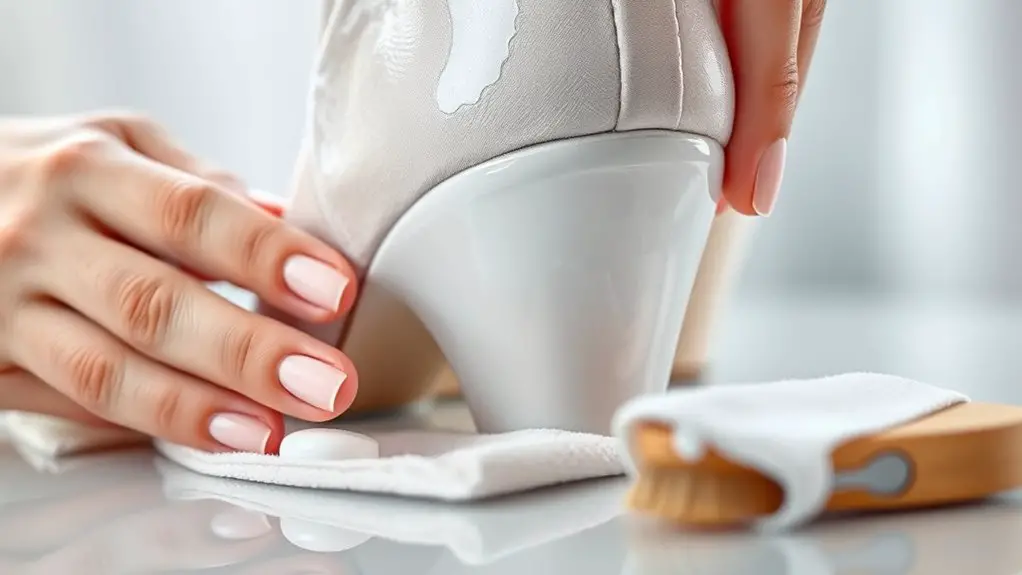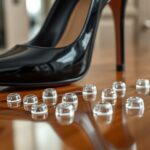To keep your heel cover from peeling, prioritize high-quality materials in your footwear. Clean them regularly with mild soap and water, and avoid excessive moisture exposure. Proper storage can prevent degradation, so use breathable bags or boxes. Apply protective sprays for added moisture and UV protection. Limit exposure to heat, and repair any minor damage promptly. Ensuring a good shoe fit is essential too. There’s more to discover about maintaining your shoes effectively.
Choose Quality Materials for Your Footwear
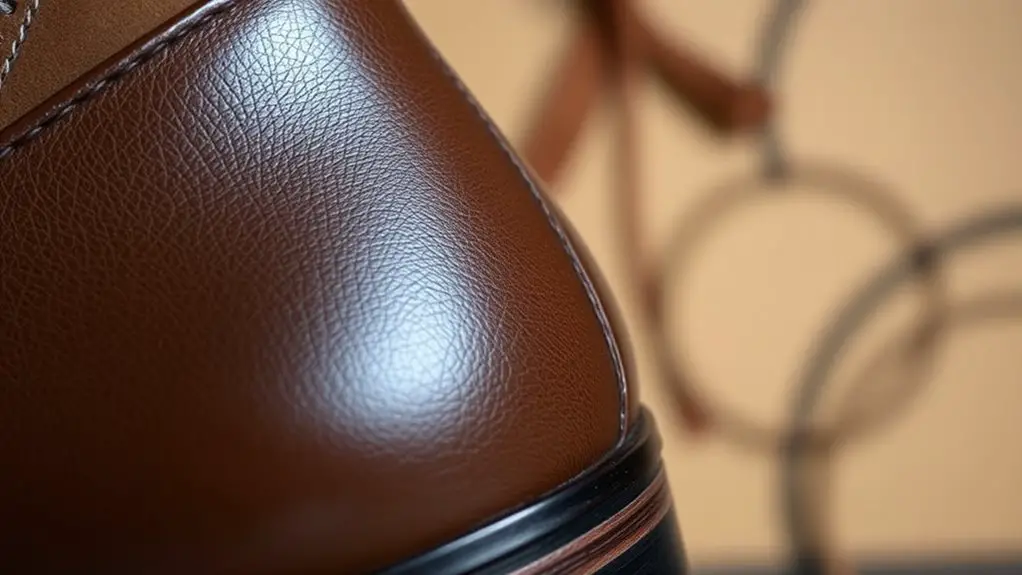
When you’re selecting footwear, it is crucial to prioritize quality materials, since they directly influence the durability and performance of your shoes. High-quality materials, such as full-grain leather, synthetic fibers, and advanced composites, enhance material durability and contribute to effective footwear construction.
These materials resist wear and tear, ensuring that your footwear can withstand daily use without degrading quickly. For instance, shoes made from breathable fabrics can help manage moisture, while rubber outsoles provide traction and flexibility.
Additionally, consider the construction techniques used, like stitching and bonding methods, as they affect the shoe’s overall integrity. A well-constructed shoe with quality materials not only lasts longer but also maintains its shape and support. By understanding the importance of material selection and construction quality, you can make informed decisions that enhance both the lifespan and comfort of your footwear, ultimately reducing the risk of heel cover peeling.
Clean Your Heel Covers Regularly
To keep your heel covers in good condition, it’s essential to clean them regularly using gentle cleaners. Harsh chemicals can damage the material, leading to peeling and wear. Establishing a maintenance schedule will help prolong the life of your heel covers and maintain their appearance.
Use Gentle Cleaners
While it’s easy to overlook, regularly cleaning your heel covers with gentle cleaners is essential for maintaining their integrity and appearance. Using gentle solutions keeps the material intact while effectively removing dirt and grime. Here are three cleaning techniques you should consider:
- Mild Soap and Water: Mix a few drops of mild soap in warm water and use a soft cloth to gently wipe the surface.
- Diluted Vinegar Solution: Combine equal parts water and white vinegar for a natural cleaner that’s safe for most materials.
- Microfiber Cloths: Utilize microfiber cloths for cleaning, as they trap dust without scratching or damaging the heel covers.
Avoid Harsh Chemicals
Cleaning your heel covers regularly is essential, but it’s equally important to choose the right cleaning products. Harsh chemicals can damage the material, leading to peeling and reduced lifespan. Instead, opt for chemical alternatives that effectively clean without compromising the integrity of your heel covers. Natural cleaners, like a mixture of mild soap and water or a vinegar solution, are excellent choices. They’re not only gentle but also environmentally friendly. When using these solutions, apply them lightly to a soft cloth and avoid soaking the covers. Rinse with a damp cloth and allow them to air dry. By avoiding harsh chemicals and choosing appropriate natural cleaners, you’ll help maintain the quality and appearance of your heel covers for longer.
Regular Maintenance Schedule
Establishing a regular maintenance schedule for your heel covers can greatly extend their lifespan and maintain their appearance. To effectively manage this, consider these key practices:
- Weekly Cleaning: Use a soft cloth to wipe down the heel covers, removing dirt and debris that can cause wear.
- Monthly Inspection: Check for signs of peeling or damage. Early detection can prevent further deterioration.
- Scheduling Reminders: Set reminders on your phone or calendar to stay consistent with your maintenance habits.
Avoid Excessive Moisture
To keep your heel covers intact, it’s essential to limit their exposure to water. Consider using waterproof protection to shield them from moisture damage, and always dry them thoroughly after use. By managing moisture effectively, you can greatly reduce the risk of peeling.
Limit Exposure to Water
While it might seem harmless to expose your heel covers to water, doing so can greatly shorten their lifespan. Excess moisture not only deteriorates the material but also increases the risk of peeling. To effectively limit exposure to water, consider the following:
- Choose Dry Environments: Avoid wearing your shoes in wet conditions, such as rain or puddles.
- Use Waterproofing Techniques: Apply suitable sprays or coatings to enhance water resistance and reduce moisture absorption.
- Regular Maintenance: Clean your heel covers regularly, ensuring no residual moisture is trapped.
Use Waterproof Protection
Moisture protection is essential for maintaining the integrity of your heel covers. To effectively prevent peeling, consider applying waterproof sprays or protective coatings. These products create a barrier that repels water and minimizes moisture absorption, which can lead to deterioration over time. When choosing a waterproof spray, verify it’s compatible with the material of your heel covers for ideal results. Apply the spray evenly and allow it to dry completely before exposure to moisture. Regularly reapply the protective coating as recommended by the manufacturer, especially after cleaning or extended use. By taking these proactive steps, you’ll greatly prolong the life of your heel covers and maintain their appearance, preventing unsightly peeling and damage.
Dry After Use
After each use, it’s essential to dry your heel covers thoroughly to prevent excessive moisture buildup. This will help maintain their integrity and prolong their lifespan. Here are some proper drying techniques you can implement:
- Air Dry: Place the heel covers in a well-ventilated area away from direct sunlight to avoid heat damage.
- Use Absorbent Materials: Employ moisture absorption methods like placing silica gel packets or absorbent cloths inside the covers to draw out excess moisture.
- Avoid Heat Sources: Never use hair dryers or radiators, as excessive heat can cause peeling or warping of the material.
Store Shoes Properly
To guarantee your shoes remain in prime condition and prevent heel covers from peeling, it’s essential to store them properly. Start by choosing a suitable shoe storage solution, such as a dedicated shoe box or a breathable cloth bag. Avoid stacking shoes or placing heavy objects on top, as this can deform their structure and damage heel covers.
Humidity control is crucial in preventing mold and deterioration. Store your shoes in a cool, dry environment, ideally with a humidity level between 40-60%. Consider using silica gel packets or dehumidifiers in your storage area to absorb excess moisture.
Additionally, try to keep your shoes away from direct sunlight, which can cause fading and weaken materials. By implementing these storage techniques, you’ll protect your shoes and greatly extend the life of the heel covers, ensuring they look great for years to come.
Use Protective Sprays
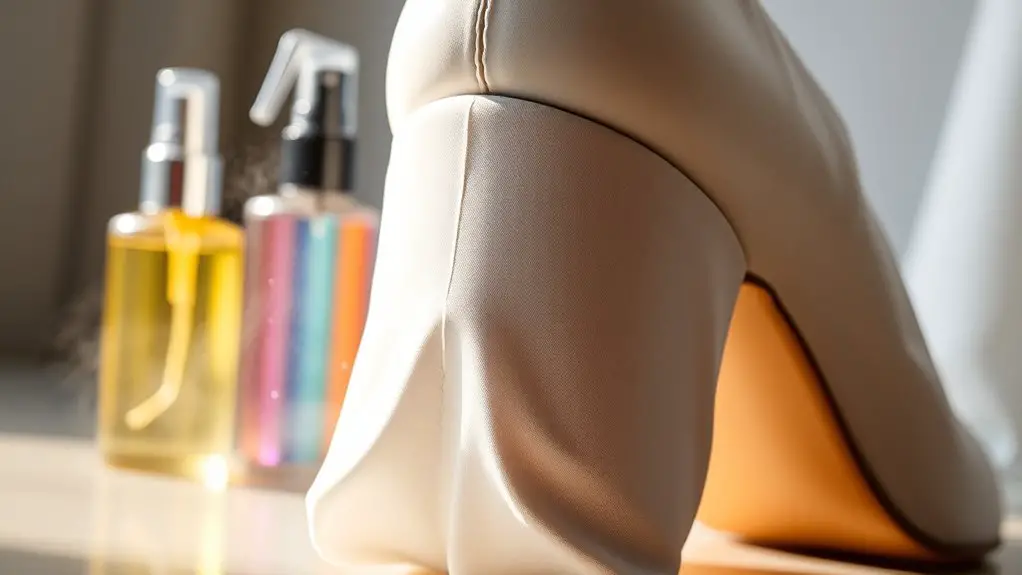
While you may think that just storing your shoes properly is enough to maintain their condition, using protective sprays can further enhance their durability and prevent heel covers from peeling. Here are some protective spray benefits and effective application techniques:
- Water Resistance: Protective sprays create a barrier against moisture, preventing damage to the heel cover from rain or spills.
- UV Protection: Many sprays offer UV protection, reducing fading and deterioration from sun exposure, which prolongs the life of your shoes.
- Easy Application: Simply spray an even coat over the heel cover, ensuring you cover all surfaces. Allow it to dry completely before wearing.
Using protective sprays regularly not only safeguards your heel covers but also helps maintain the overall aesthetics of your shoes. Be proactive in your shoe care routine to keep them looking great longer.
Rotate Your Footwear
Rotating your footwear is essential for extending the life of your shoes, especially when it comes to preventing heel covers from peeling. Regular shoe rotation allows each pair to rest and recover from the stresses of daily wear. When you wear the same shoes every day, the materials don’t have time to breathe, leading to accelerated wear and tear. By alternating between pairs, you can maintain the integrity of the heel covers, as they won’t be subjected to constant pressure and moisture.
Additionally, shoe rotation contributes to better foot health. Different shoes offer varied support and cushioning, which can help distribute your body weight more evenly and reduce the risk of injuries. Aim to have at least three pairs in your rotation, allowing each pair to dry out completely before wearing it again. This simple practice not only protects your heel covers but also enhances your overall comfort and foot health.
Limit Exposure to Heat
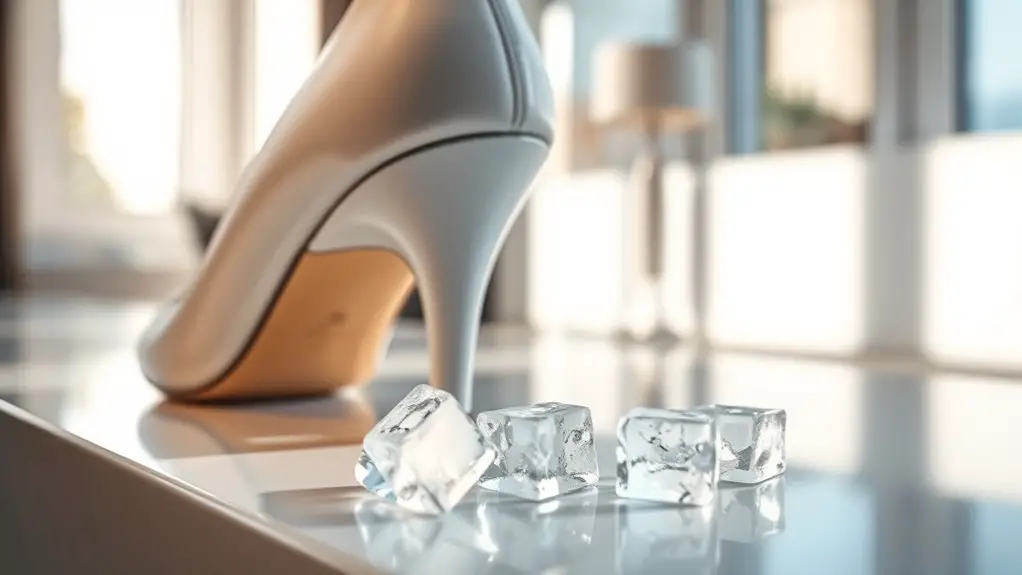
Maintaining the integrity of your heel covers involves more than just rotating your footwear; it also means being mindful of heat exposure. Excessive heat can cause the materials in your heel covers to weaken and peel over time. To protect them, consider these tips:
- Avoid Direct Sunlight: When storing your shoes, keep them out of direct sunlight to prevent overheating and temperature fluctuations that can damage the adhesive.
- Steer Clear of Heat Sources: Keep your heels away from radiators, heaters, or other heat sources that can raise the temperature around them, compromising their structure.
- Monitor Storage Conditions: Store your shoes in a cool, dry place. Extreme temperatures can lead to unwanted wear and tear on your heel covers.
Repair Minor Damage Promptly
To keep your heel cover in top condition, you should inspect it regularly for any signs of damage. If you spot minor issues, use the appropriate repair tools and apply a strong adhesive carefully to address them promptly. Taking these steps can prevent further deterioration and extend the life of your heel cover.
Inspect Regularly for Damage
Although it might seem tedious, inspecting your heel cover regularly for damage is essential to prolonging its lifespan. Establish an inspection frequency that suits your usage, ideally once a week. This routine helps catch any damage types early, preventing further deterioration.
Here are key aspects to check during your inspection:
- Cracks or splits: Look for any visible signs that could worsen over time.
- Peeling edges: Examine the edges where the cover meets the shoe; these areas are often vulnerable.
- Color fading: Check for discoloration, which can indicate wear and tear.
Use Appropriate Repair Tools
When you notice minor damage on your heel cover, using the right repair tools can make all the difference in extending its life. Start by gathering essential repair tools, including a small brush, a precision knife, and a pair of tweezers. These will help you clean and prepare the damaged area effectively. Next, consider your adhesive options; a strong, flexible adhesive is ideal for heel covers. Be certain to select one specifically designed for the material of your heel cover to guarantee a strong bond. Promptly addressing minor damage with these tools not only prevents further peeling but also maintains the overall integrity of your footwear. Remember, a little care goes a long way in preserving your heel cover.
Apply Strong Adhesive Carefully
Applying strong adhesive carefully is essential if you want to repair minor damage to your heel cover effectively. Choosing the right adhesive types and mastering application techniques can make a significant difference. Here are three steps to follow:
- Select the Right Adhesive: Use a flexible adhesive suitable for rubber or leather, ensuring it bonds effectively without hardening.
- Clean the Surface: Before applying, clean the damaged area thoroughly to remove dirt and oils, which can hinder adhesion.
- Apply Evenly: Use a precision applicator to apply a thin, even layer of adhesive. Avoid excess, as it can ooze and create a messy finish.
Be Mindful of Shoe Fit
Choosing the right shoe fit is essential to preventing heel covers from peeling. Proper shoe sizing guarantees that your shoes aren’t too tight or too loose, which can cause excessive friction and stress on the heel area. When selecting shoes, consider your unique foot shape, as this can considerably impact comfort and durability. A shoe that accommodates your natural contours will provide better support and reduce movement that can contribute to peeling.
When trying on shoes, pay attention to how they feel around the heel and arch. If you notice any discomfort or pressure points, it’s a sign that the fit may not be ideal. Additionally, shoes that are too large can allow your foot to slide, increasing the risk of wear on the heel cover. By prioritizing the right fit, you’ll not only enhance comfort but also prolong the life of your heel covers.
Seek Professional Help When Needed
If you’re struggling with persistent issues related to heel cover peeling, it’s wise to seek professional help. A professional cobbler can provide tailored solutions that guarantee your shoes remain in peak condition. Here are three reasons why consulting a shoe repair expert is beneficial:
- Expert Diagnosis: A cobbler can identify the root cause of peeling, whether it’s due to material fatigue, improper fit, or environmental factors.
- Quality Repairs: They use high-quality materials and techniques that restore your heel cover effectively, extending the life of your shoes.
- Preventive Solutions: Professionals can offer advice on maintaining your shoes, including recommended products that minimize wear and tear.
Don’t ignore ongoing issues; addressing them early with a professional can save you money and prolong the life of your favorite footwear. Remember, investing in shoe repair can make all the difference in preserving your heel covers.
Frequently Asked Questions
How Often Should I Replace My Heel Covers?
Imagine stepping onto a smooth surface, your heel cover shining bright. For ideal heel cover maintenance, replace them every 6-12 months, depending on wear and replacement frequency—ensuring your footwear remains functional and stylish.
Can I Use Regular Shoe Polish on Heel Covers?
You shouldn’t use regular shoe polish on heel covers. Instead, opt for products specifically designed for synthetic materials. Using appropriate polish types guarantees effective shoe maintenance and prevents damage to the heel cover’s integrity over time.
What Materials Are Best for Heel Covers?
When considering materials for heel covers, leather offers durability and style, while rubber provides excellent grip and flexibility. You’ll find adhesive properties vary; rubber typically adheres better, ensuring longer-lasting wear and protection.
Do Heel Covers Come in Different Sizes?
Yes, heel covers come in various sizes. When selecting, consider heel cover types and guarantee proper heel cover fitting for ideal comfort and support. A good fit prevents slippage and enhances performance during use.
Are There Specific Brands Known for Durable Heel Covers?
When considering brand durability in heel cover comparisons, look for established brands known for quality materials. Research customer reviews to identify which brands consistently produce long-lasting, resilient heel covers that withstand regular wear and tear effectively.

